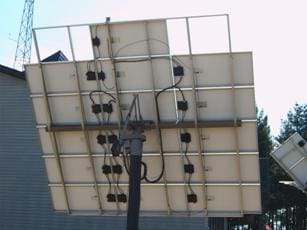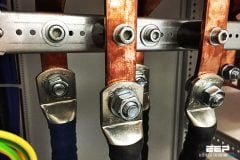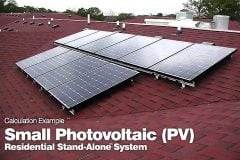 Copper conductors are recommended for almost all photovoltaic system wiring. Copper conductors have lower voltage drops and better resistance to corrosion than other types of comparably sized conductor materials. Aluminum or copper-clad aluminum wires can be used in certain applications, but the use of such cables is not recommended- particularly in dwellings.
Copper conductors are recommended for almost all photovoltaic system wiring. Copper conductors have lower voltage drops and better resistance to corrosion than other types of comparably sized conductor materials. Aluminum or copper-clad aluminum wires can be used in certain applications, but the use of such cables is not recommended- particularly in dwellings.
All wire sizes presented in this guide refer to copper conductors. The NEC requires 12 AWG (American Wire Gage) or larger conductors to be used with systems under 50 volts. Article 690 ampacity calculations yielding a smaller conductor size might override Article 720 considerations, but some inspectors are using the Article 720 requirement for dc circuits [690.3].
The Code has little information for conductor sizes smaller than 14 AWG, but Section 690.31(D) provides some guidance. Many listed PV modules are furnished with attached 14 AWG conductors.
Single-conductor, Type UF (Underground Feeder—Identified (marked) as Sunlight Resistant), Type SE (Service Entrance), or Type USE/USE-2 (Underground Service Entrance) cables are permitted for module interconnect wiring. Type UF cable must be marked “Sunlight Resistant” when exposed outdoors as it does not have the inherent sunlight resistance found in SE and USE conductors [UL Marking Guide for Wire and Cable].
Unfortunately, single-conductor, stranded, UF sunlight-resistant cable is not readily available and may have only a 60°C temperature rating. This 60°C rated insulation is not suitable for long-term exposure to direct sunlight at temperatures likely to occur near PV modules. Such wire has shown signs of deterioration after four years of exposure. Temperatures exceeding 60°C normally occur in the vicinity of the modules; therefore, conductors with 60°C insulation cannot be used.
Stranded wire is suggested to ease servicing of the modules after installation and for durability. The widely available Underground Service Entrance Cable (USE-2) is suggested as the best cable to use for module interconnects. When manufactured to the UL Standards, it has a 90°C temperature rating and is sunlight resistant even though not commonly marked as such. The “-2” marking indicates a wet-rated 90°C insulation, the preferred rating.
Additional markings indicating XLP or XLPE (cross-linked polyethylene) and RHW-2 (90°C insulation when wet) ensure that the highest quality cable is being used [Tables 310.13, 16, and 17].
 An additional marking (not required) of “Sunlight Resistant” indicates that the cable has passed an extended UV exposure test over that normally required by USE-2. USE-2 is acceptable to most electrical inspectors. The RHH and RHW-2 designations frequently found on USE-2 cable allow its use in conduit inside buildings. USE or USE-2 cables, without the other markings, do not have the fire-retardant additives that SE and RHW/RHW-2 cables have and cannot be used inside buildings.
An additional marking (not required) of “Sunlight Resistant” indicates that the cable has passed an extended UV exposure test over that normally required by USE-2. USE-2 is acceptable to most electrical inspectors. The RHH and RHW-2 designations frequently found on USE-2 cable allow its use in conduit inside buildings. USE or USE-2 cables, without the other markings, do not have the fire-retardant additives that SE and RHW/RHW-2 cables have and cannot be used inside buildings.
If a more flexible, two-conductor cable is needed, electrical tray cable (Type TC) is available but must be supported in a specific manner as outlined in the NEC [336 and 392]. TC is sunlight resistant and is generally marked as such.
Although sometimes used (improperly) for module interconnections, SO, SOJ, and similar flexible, portable cables and cordage may not be sunlight resistant and are not approved for fixed (non-portable) installations [400.7, 8].
The temperature derated ampacity of conductors at any point must generally be at least 156% of the module (or array of parallel-connected modules) rated shortcircuit current at that point [690.8(A), (B)].











IEC 62446 For testing methods
In UK is in use serie of BS standards:
BS EN 50380:2003 Datasheet and nameplate information for photovoltaic modules
BS EN 50461:2006 Solar cells. Datasheet information and product data for crystalline silicon solar cells
BS EN 50513:2009 Solar wafers. Data sheet and product information for crystalline silicon wafers for solar cell manufacturing
BS EN 50521:2008 Connectors for photovoltaic systems. Safety requirements and tests
BS EN 50524:2009 Data sheet and name plate for photovoltaic inverters
BS EN 50530:2010 Overall efficiency of grid connected photovoltaic inverters
BS EN 50548:2011 Junction boxes for photovoltaic modules
BS EN 60891:2010 Photovoltaic devices. Procedures for temperature and irradiance corrections to measured I-V characteristics
BS EN 60904-10:2010 Photovoltaic devices. Methods of linearity measurement
BS EN 60904-1:2006 Photovoltaic devices. Measurement of photovoltaic current-voltage characteristics
BS EN 60904-2:2007 Photovoltaic devices. Requirements for reference solar devices
BS EN 60904-3:2008 Photovoltaic devices. Measurement principles for terrestrial photovoltaic (PV) solar devices with reference spectral irradiance data
BS EN 60904-4:2009 Photovoltaic devices. Reference solar devices. Procedures for establishing calibration traceability
BS EN 60904-5:2011 Photovoltaic devices. Determination of the equivalent cell temperature (ECT) of photovoltaic (PV) devices by the open-circuit voltage method
BS EN 60904-7:2009 Photovoltaic devices. Computation of the spectral mismatch correction for measurements of photovoltaic devices
BS EN 60904-8:1998 (IEC 60904-8:1998) Photovoltaic devices. Measurement of spectral response of a photovoltaic (PV) device
BS EN 60904-9:2007 Photovoltaic devices. Solar simulator performance requirements
BS EN 61215:2005 Crystalline silicon terrestrial photovoltaic (PV) modules. Design qualification and type approval
BS EN 61345:1998 (IEC 61345:1998) UV test for photovoltaic (PV) modules
BS EN 61646:2008 Thin-film terrestrial photovoltaic (PV) modules. Design qualification and type approval
BS EN 61683:2000 (IEC 61683:1999) Photovoltaic systems. Power conditioners. Procedure for measuring efficiency
BS EN 61701:2000 (IEC 61701:1995) Salt mist corrosion testing of photovoltaic (PV) modules
BS EN 61702:2000 (IEC 61702:1995) Rating of direct coupled photovoltaic (PV) pumping systems
BS EN 61724:1998 (IEC 61724:1998) Photovoltaic system performance monitoring. Guidelines for measurement, data exchange and analysis
BS EN 61725:1997 (IEC 61725:1997) Analytical expression for daily solar profiles
BS EN 61730-1:2007 Photovoltaic (PV) module safety qualification. Requirements for construction
BS EN 61730-2:2007 Photovoltaic (PV) module safety qualification. Requirements for testing
BS EN 61829:1998 (IEC 61829:1995) Crystalline silicon photovoltaic (PV) array. On-site measurement of I-V characteristics
BS EN 61853-1:2011 Photovoltaic (PV) module performance testing and energy rating. Irradiance and temperature performance measurements and power rating
BS EN 62093:2005 Balance-of-system components for photovoltaic systems. Design qualification natural environments
BS EN 62108:2008 Concentrator photovoltaic (CPV) modules and assemblies. Design qualification and type approval
BS EN 62109-1:2010 Safety of power converters for use in photovoltaic power systems. General requirements
BS EN 62116:2011 Test procedure of islanding prevention measures for utility-interconnected photovoltaic inverters
BS EN 62124:2005 Photovoltaic (PV) stand-alone systems. Design verification
BS EN 62253:2011 Photovoltaic pumping systems. Design qualification and performance measurements
BS EN 62446:2009 Grid connected photovoltaic systems. Minimum requirements for system documentation, commissioning tests and inspection
BS EN 62509:2011 Battery charge controllers for photovoltaic systems. Performance and functioning
DD CLC/TS 61836:2009 Solar photovoltaic energy systems. Terms, definitions and symbols
DD IEC/TS 62257-12-1:2007 Recommendations for small renewable energy and hybrid systems for rural electrification. Selection of self-ballasted lamps (CFL) for rural electrification systems and recommendations for household lighting equipment
DD IEC/TS 62257-3:2004 Recommendations for small renewable energy and hybrid systems for rural electrification. Project development and management
DD IEC/TS 62257-4:2005 Recommendations for small renewable energy and hybrid systems for rural electrification. System selection and design
DD IEC/TS 62257-5:2005 Recommendations for small renewable energy and hybrid systems for rural electrification. Protection against electrical hazards
DD IEC/TS 62257-6:2005 Recommendations for small renewable energy and hybrid systems for rural electrification. Acceptance, operation, maintenance and replacement
DD IEC/TS 62257-7-3:2008 Recommendations for small renewable energy and hybrid systems for rural electrification. Generator set. Selection of generator sets for rural electrification systems
DD IEC/TS 62257-7:2008 Recommendations for small renewable energy and hybrid systems for rural hybrid systems for rural electrification. Generators
DD IEC/TS 62257-8-1:2007 Recommendations for small renewable energy and hybrid systems for rural electrification. Selection of batteries and battery management systems for stand-alone electrification systems. Specific case of automotive flooded lead-acid batteries available in developing countries
DD IEC/TS 62257-9-1:2008 Recommendations for small renewable energy and hybrid systems for rural electrification. Micropower systems
DD IEC/TS 62257-9-2:2006 Recommendations for small renewable energy and hybrid systems for rural electrification. Microgrids
DD IEC/TS 62257-9-3:2006 Recommendations for small renewable energy and hybrid systems for rural electrification. Integrated system. User interface
DD IEC/TS 62257-9-4:2006 Recommendations for small renewable energy and hybrid systems for rural electrification. Integrated system. User installation
DD IEC/TS 62257-9-5:2007 Recommendations for small renewable energy and hybrid systems for rural electrification. Integrated system. Selection of portable PV lanterns for rural electrification projects
DD IEC/TS 62257-9-6:2008 Recommendations for small renewable energy and hybrid systems for rural electrification. Integrated system. Selection of photovoltaic individual electrification systems (PV-IES)
THANKS, SHAME THEY WERE MENTIONED IN THE ORIGINAL ARTICLE ON UK FACEBOOK. uK CUSTOMERS NEED TO KNOW WHAT THEY NEED TO USE.
Do not understand why my comment is awaiting ‘moderation
Sorry, but there a hundreds of spam comments daily, so moderation is a must. However, I’m trying moderate and answer all comments as soon as possible.
Thanks for understanding.
Interesting only American Standads quoted for cables, what standards apply in the UK?